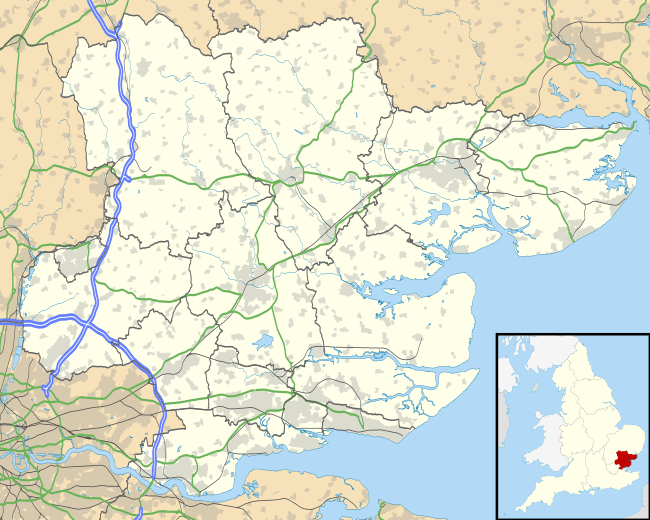Kelvedon
| Kelvedon | |
 St. Mary the Virgin church, Kelvedon |
|
 Kelvedon |
|
| Population | 4,717 (2001) 3,587 (2011)[1] |
|---|---|
| OS grid reference | TL861184 |
| Civil parish | Kelvedon |
| District | Braintree |
| Shire county | Essex |
| Region | East |
| Country | England |
| Sovereign state | United Kingdom |
| Post town | COLCHESTER |
| Postcode district | CO5 |
| Dialling code | 01376 |
| Police | Essex |
| Fire | Essex |
| Ambulance | East of England |
| EU Parliament | East of England |
Coordinates: 51°49′59″N 0°41′56″E / 51.833°N 0.699°E
Kelvedon is a village and civil parish in the Braintree District of Essex in England, near to the town of Witham. It has a population of 4,717,[2] reducing to 3,587 at the 2011 Census.[1]
Origins
The existing village of Kelvedon has been a settlement since the Early Middle Ages, though it stands near (and partly on) the site of a Roman settlement, probably Canonium. Kelvedon expanded significantly in the Victorian era. The reason was the Norwich to London railway making it a place to live yet get to work as rail was the only fast method of transport. Victorian Kelvedon was set along one street, High Street. In the 1930s, with the advent of the automobile, High Street became the A12, the main road through Essex. Ribbon development saw houses sprawl along the road for miles. The village suffered major congestion until a bypass was built in the 1960s. Suburbanization started to take place in the 1980s - a large development called Riverside Park was constructed containing hundreds of homes.
Kelvedon is situated next to the village of Feering and is separated from it by the River Blackwater. The River Blackwater was spanned by a packhorse bridge, built around 1750, which was an essential part of the main road carrying traffic from Norfolk and Suffolk to London and this feature was significant in making Kelvedon an important staging post on the main route to London, as could be seen from the numerous inns and hostelries which served the area.
In the late 19th century, Kelvedon became famous for seed growing, and the firm of Kings Seeds, now part of Associated British Foods, became famous for the production of flower and vegetable seeds. Another large seed merchant, based nearby in the hamlet of Inworth, and trading worldwide was E W Deal & Sons (a founder member of Asmer Seeds based in Leicester) who were famous for developing the Kelvedon Wonder Pea and other varieties of flowers and vegetables.
Kelvedon today
The village is bounded to the north by the river Blackwater where the adjacent village of Feering starts. Kelvedon contains a school called Kelvedon St Mary's. The original school (Ayletts Foundation School) in Kelvedon was founded by Thomas Aylett in Maldon Road, Kelvedon, in 1632 when he bequeathed the property along with £10 per annum to provide a salary for a master. The school closed in 1944 and was replaced by the Kelvedon St Mary's School located on the corner of High Street and Easterford Road (now the Kelvedon and Feering Health Centre) which was in turn replaced in 1977 by a new school located in Docwra Road. The Ayletts building still stands today and houses the Kelvedon Library and Museum. Brockwell Meadows Local Nature Reserve is south-east of the village between the houses and the River Blackwater.
Kelvedon is also home to several businesses including Knight Group and Lysanda.
Transport
Kelvedon railway station is on the London Liverpool St. line with trains approximately every 20 minutes. Bus services are provided by the 71 First Bus service Chelmsford–Colchester route and the Hedingham & District 91 service from Tollesbury–Witham. The A12 has links with the rest of East Anglia and the north.
Education
Kelvedon St Mary's is a Church of England primary school with academy status located between Colchester and Chelmsford on the A12, which was opened in 1977. It converted to academy status in March 2013.
Notable residents
- C.H. Spurgeon, known as the "Prince of Preachers", was born in Kelvedon on 19 June 1834. Charles Spurgeon was a powerful preacher of the Victorian era and boasted the largest congregation in London, to the extent that his weekly sermon was printed and sold by the thousands. The Metropolitan Tabernacle was built for him. Charles Spurgeon never returned to Kelvedon to preach although he was invited in 1853 to do so in the new Independent Chapel built in the village, an invitation which he refused. There is a blue plaque on a building in Kelvedon High Street commemorating the place of his birth.
- Actress Juliet Stevenson was born in Kelvedon.
- Actor Jeremy Sheffield, spent part of his childhood living in Kelvedon.
- Actor John Dagleish was born and raised in Kelvedon.
References
- 1 2 "Civil Parish 2011". Neighbourhood Statistics. Office for National Statistics. Retrieved 4 September 2016.
- ↑ Office for National Statistics : Census 2001 : Parish Headcounts : Braintree Retrieved 2009-11-24
External links
| Wikimedia Commons has media related to Kelvedon, Essex. |